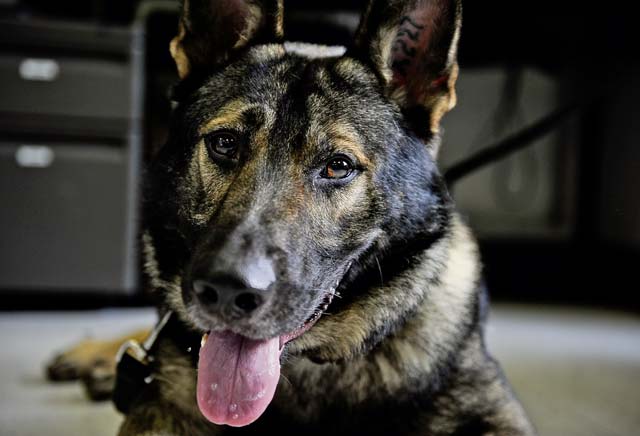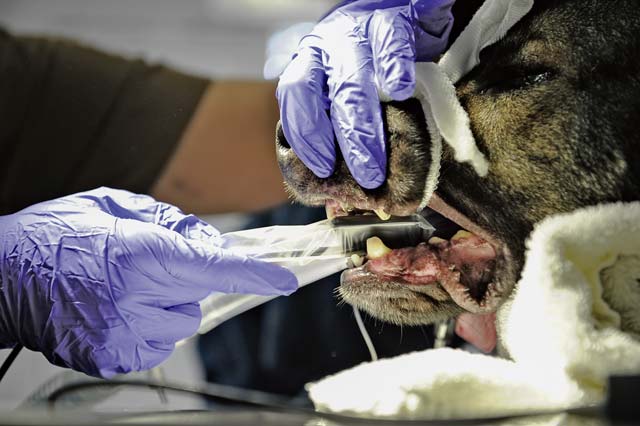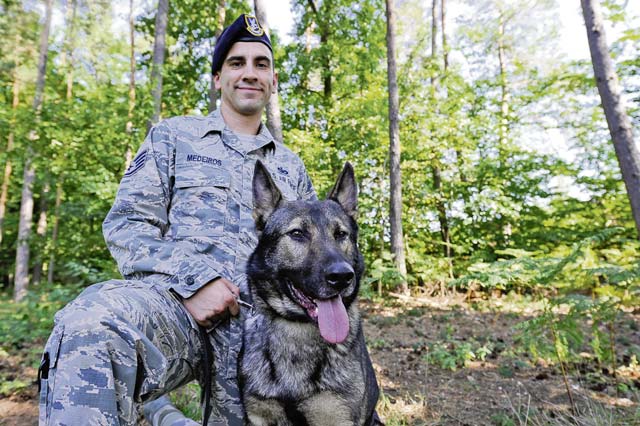


They step from the car, wagging their faithful tails as they trot next to their partners. Children squeal with delight as they see them, but Airmen know that as fluffy as they are, military working dogs are not a household pet.
America’s cutest heroes, MWDs are revered for the abilities they use to ensure the safety of those they fight for.
Due to the nature of their work, these K-9s are prone to dental injuries and depend on local dental clinics to help keep them in good working condition.
After biting down onto a steel pipe during training, Kobo, 86th Security Forces Squadron MWD, recently underwent two non-surgical procedures for the extraction of his upper incisors and a surgical extraction of his upper fourth premolar at Veterinary Medical Center Europe, Pulaski Barracks, Aug. 25.
Soldiers from Veterinary Medical Center Europe partnered with Airmen from the 86th Dental Squadron to extract Kobo’s broken tooth, rather than use the self-developing films they had.
“When it comes time to do complicated tooth extractions or root canals, standard of care is to have access to radiography,” said U.S. Army Capt. Kelsey Fiddes, Veterinary Medical Center Europe outpatient services chief at Public Health Activity-Rheinland-Pfalz. “The 86th Dental Squadron lent us digital radiography that is much faster and helps us to minimize the amount of time the dogs spend under anesthesia.”
Using Ramstein Dental Clinic’s digital radiograph sensor and computer software with Veterinary Medical Center Europe’s portable x-ray unit, both units were able to take digital radiographs of Kobo’s teeth faster and easier than the self-developing radiograph films.
The dentists are also much more familiar with and have access to specialized dental equipment and knowledge of more intricate procedures than veterinarians do.
“Veterinarians commonly deal with a small amount of every medical specialty: dentistry, surgery, internal medicine, oncology, radiology, pharmacy, etc.,” Fiddes said, “So it’s great to be able to work with these Airmen that have specialized in one of those areas and can offer detailed tips and insight on how to complete the procedures more efficiently and effectively.”
Military working dogs are the reason Fiddes comes to work every day and believes the K-9s deserve the best care.
“People always underestimate our working dogs, and never give them enough credit for the work they do and the lives they save,” Fiddes said. “It is the highlight of my job to see them work, train, and succeed in everything they do. With the amount of work they do for us, the least we can do is provide them with the best medical care we are able.”
The equipment made it possible to evaluate for any signs of infection, abscess, or inflammation that may be present in a safer and more efficient way, making it easier to determine if Kobo’s teeth needed to come out.
“It’s always great when we can use our resources to help each other out,” said Capt. Christianna Moore, 86th DS general dentist. “We want to make sure MWDs are as healthy and well-maintained as possible, and letting that tooth sit in Kobo’s gums would’ve led to an infection.”
Having that strong working relationship with one another allowed both the 86th DS and Veterinary Medical Center Europe to collaborate on a more complex dental procedure, leaving Kobo ready and fit to fight, as well as ensuring that relationship will only continue to grow stronger.


